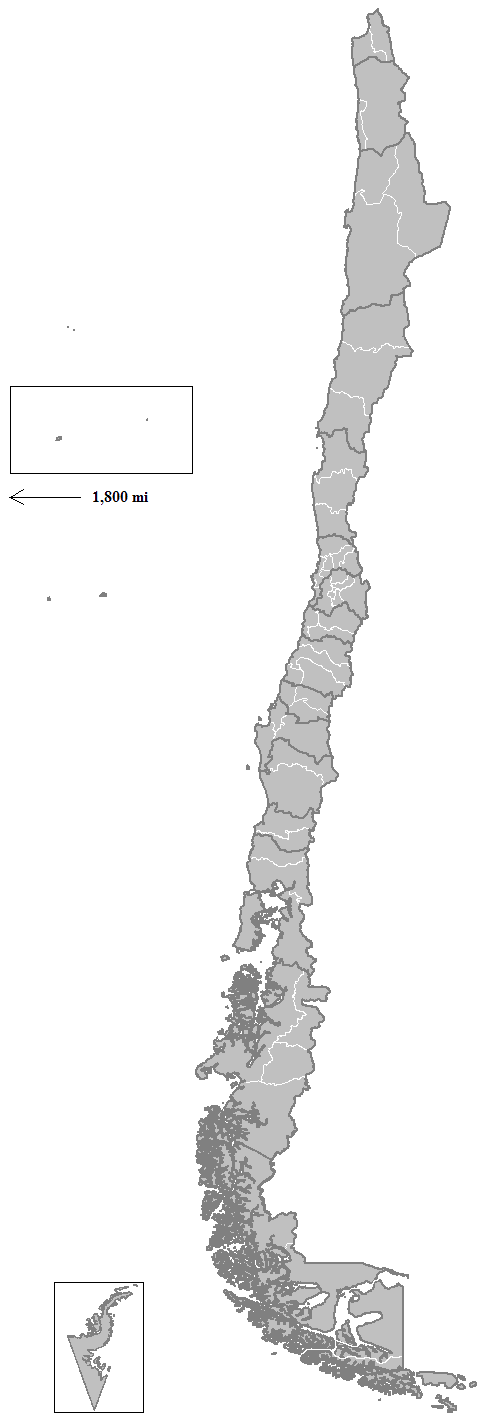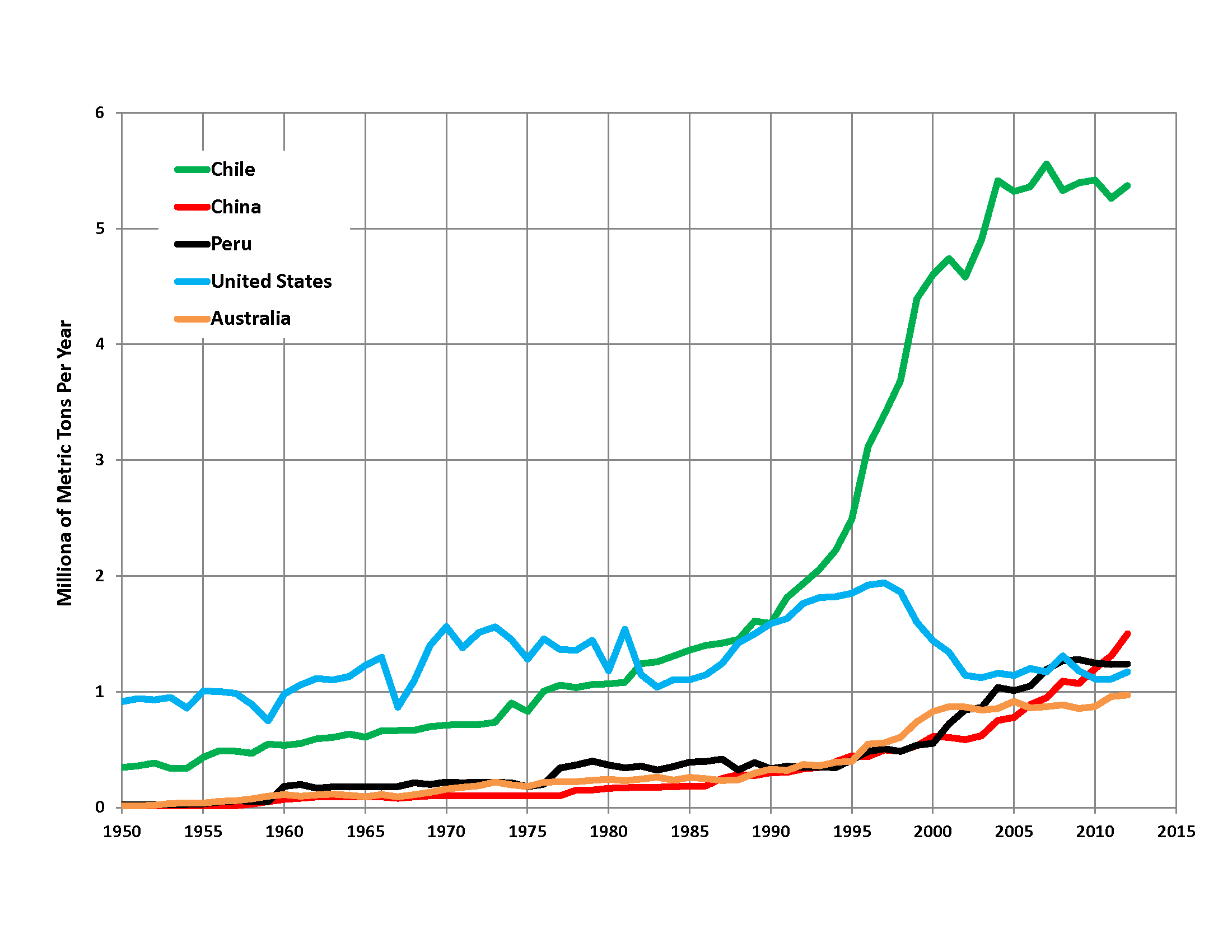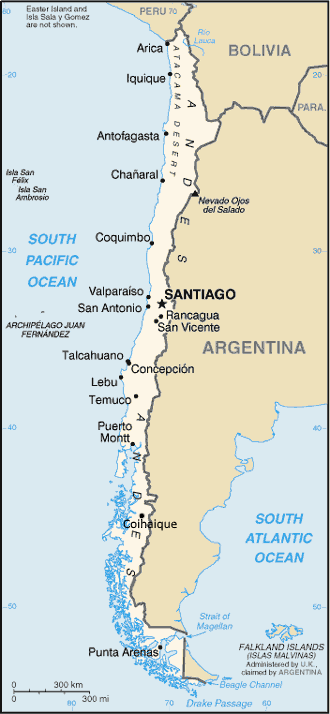|
Copiapó
Copiapó () is a List of cities in Chile, city and communes of Chile, commune in northern Chile, located about 65 kilometers east of the coastal List of towns in Chile, town of Caldera, Chile, Caldera. Founded on December 8, 1744, it is the capital of Copiapó Province and Atacama Region. Copiapó lies about 800 km north of Santiago, Chile, Santiago by the Copiapó River, in the valley of the same name. In the early 21st century, the river has dried up in response to climate change and more severe droughts. The town is surrounded by the Atacama Desert and receives 12 mm (½ in) of rain per year. The population of Copiapó was 9,128 in 1903; and 11,617 in 1907. As of 2012, there are 158,438 inhabitants. Copiapó is in a rich silver and copper mining in Chile, copper mining district, and while it attends large-scale mining operations further afar it is the central town of surrounding medium-scale mining mining district. A bronze statue commemorates Juan Godoy, discoverer ... [...More Info...] [...Related Items...] OR: [Wikipedia] [Google] [Baidu] |
Copiapó Province
Copiapó Province () is one of three provinces of the northern Chilean region of Atacama (III). Its capital is the city of Copiapó. Geography and demography According to the 2012 census by the National Statistics Institute (''INE''), the province spans an area of and had a population of 183,973 inhabitants, giving it a population density of . It is the tenth largest province in the country. Between the 1992 and 2002 censuses, the population grew by 24.9% (31,021 persons). Administration As a province, Copiapó is a second-level administrative division of Chile, which is further divided into three communes (''comunas''). The province is administered by a presidentially appointed regional delegate. Communes #Copiapó #Caldera A caldera ( ) is a large cauldron-like hollow that forms shortly after the emptying of a magma chamber in a volcanic eruption. An eruption that ejects large volumes of magma over a short period of time can cause significant detriment to the str ... # ... [...More Info...] [...Related Items...] OR: [Wikipedia] [Google] [Baidu] |
Caldera, Chile
Caldera is a port city and commune in the Copiapó Province of the Atacama Region in northern Chile. It has a harbor protected by breakwaters, being the port city for the productive mining district centering on Copiapó to which it is connected by the first railroad constructed in Chile. Geography and climate Caldera lies about west of Copiapó on the Pacific. The climate is mostly warm and extremely dry, because of its location on the Atacama desert's coast, but the temperatures are moderated by the cooling sea currents. However, lately the climate has become colder due to the climatic change. The commune spans an area of . History On 31 August 1420, the territory where the city is currently located, was shaken by an 8.8 to 9.4 mega-earthquake, the first major earthquake recorded in the history of Chile. In 1687, Englishman Edward Davis reached the ''Playa Bahia Inglesa'' south of Caldera. In 1840, William Wheelwright of the Pacific Steam Navigation Company visited ... [...More Info...] [...Related Items...] OR: [Wikipedia] [Google] [Baidu] |
Juan Godoy
Juan Godoy (1800 – 1842) was a Chilean farmer and miner who in 1832 discovered an outcrop (''reventón'') of silver south of Copiapó in Chañarcillo, sparking the Chilean silver rush. Villalobos, Sergio; Silva, Osvaldo; Silva Fernando and Estelle, Patricio. Historia de Chile. Editorial Universitaria 1995. First Edition: 1974. p. 469–472. Godoy was born to Flora Normilla, an indigenous woman, in the reduction of San Fernando in 1800. Later, he was baptized in the town of Copiapó. Godoy is referred to in sources as a mestizo, implying his father was not indigenous. His surname Godoy is a hispanization of Normilla. He worked variously as goatherd and farmer with his mother but also as miner and woodcutter before the discovery of Chañarcillo. Godoy was very likely illiterate. It is said that Godoy found the outcrop while hunting guanacos. Godoy was able to recognise the silver outcrop since he had previously worked in mining as explosives driller (''barretero'') and apire ... [...More Info...] [...Related Items...] OR: [Wikipedia] [Google] [Baidu] |
Copiapó River
Copiapó River is a river of Chile located in the Atacama Region. Starting at the confluence of the ''Jorquera'' and ''Pulido'' rivers, the Copiapó flows for only 2.5 km before receiving the waters of the '' Manflas River''. It flows through the city of Copiapó. See also * List of rivers of Chile This list of rivers of Chile includes all the major rivers of Chile. See each article for their tributaries, drainage areas, etc. Usually significant tributaries appear in this list, under the river into which they drain. Rivers by name Following ... References Rivers of Atacama Region Rivers of Chile {{Chile-river-stub ... [...More Info...] [...Related Items...] OR: [Wikipedia] [Google] [Baidu] |
Chañarcillo
Chañarcillo is a town and mine in the Atacama Desert of Copiapó Province, Atacama Region, Chile, located near Vallenar and 60 km from Copiapó. It is noted for its silver mining. The town grew after the Chañarcillo silver mine, discovered on May 16, 1832, by Juan Godoy, sparked the Chilean silver rush. Villalobos, Sergio; Silva, Osvaldo; Silva Fernando and Estelle, Patricio. ''Historia de Chile''. Editorial Universitaria 1995. First Edition: 1974. p. 469-472. It grew in prominence in the second half of the nineteenth century and became important in the Atacama mining industry and one of the most important mines to the Chilean economy. It was connected by railway before 1862. Today the settlement is largely in ruins. The Chanarcillo District produced at least $100 million in silver before abandonment. This production from up to 20 mines was limited to a third of a square mile. From 1860 until 1885, 2,500,000 kg of silver was produced. Most production occurred before 1930. Fro ... [...More Info...] [...Related Items...] OR: [Wikipedia] [Google] [Baidu] |
Communes Of Chile
A commune (, ) is the smallest administrative subdivision in Chile. It may contain cities, towns, villages, hamlets as well as rural areas. In highly populated areas, such as Santiago, Valparaíso and Concepción, a conurbation may be broken into several communes. In sparsely populated areas, conversely, a commune may cover a substantial rural area together with several settled areas which could range from hamlets to towns or cities. The term "commune" is ambiguous in English, but the word is commonly used in translation for "comuna", although with some controversy among translators. A comuna is similar to a "county" in Anglo-American usage and practice, and may be more universally understood as a "municipality". Each commune or municipality is governed by a directly elected body known as a municipal council (''concejo municipal'') consisting of a mayor (''alcalde'') and a group of councillors (''concejales''), for a period of four years. The communal civil service admin ... [...More Info...] [...Related Items...] OR: [Wikipedia] [Google] [Baidu] |
Provinces Of Chile
A province is a second-level administrative division in Chile. There are 56 in total. The top-level administrative division in Chile is the regions of Chile, region. There are 16 in total. Each provincial presidential delegation (''delegación presidencial provincial'') is headed by a provincial presidential delegate (''delegado presidencial provincial'') appointed by the President of Chile, President. The governor exercises their powers in accordance with instructions from the regional presidential delegate (''delegado presidencial regional''). The provincial delegate is advised by the Provincial Economic and Social Council (''Consejo Económico y Social Provincial'' or CESPRO). No provincial presidential delegations exist in those provinces where the regional capital is located; its functions were merged with those of the regional presidential delegate. The country's provinces are further divided into 346 communes of Chile, communes which are administered by an alcalde and m ... [...More Info...] [...Related Items...] OR: [Wikipedia] [Google] [Baidu] |
Copper Mining In Chile
Chile is the world's largest producer of copper and has been so uninterruptedly since 1983. This activity provides a substantial part of the Chilean state's revenue: slightly less than 6% in 2020, with state-owned copper company Codelco alone generating 2.6% of state revenue. Mining of copper in Chile is done chiefly on giant low-grade porphyry copper deposits which are primarily mined by the following companies; Codelco, BHP, Antofagasta Minerals, Anglo American plc, Anglo American and Glencore. Together these companies stood for 83.6% of the copper output in Chile in 2019 and many copper mining companies are joint ventures involving one at least one of these. Medium-scale mining in Chile, which focuses mainly on copper, produced about 4.5% of the copper mined in the country from 2017 to 2021. Copper is also the main product of small-scale mining in Chile, with about 95% of small-scale miners working in copper mining. One estimate puts the number of active copper mines in Chile ... [...More Info...] [...Related Items...] OR: [Wikipedia] [Google] [Baidu] |
Atacama Desert
The Atacama Desert () is a desert plateau located on the Pacific Ocean, Pacific coast of South America, in the north of Chile. Stretching over a strip of land west of the Andes Mountains, it covers an area of , which increases to if the barren lower slopes of the Andes are included. The Atacama Desert is the driest nonpolar desert in the world, and the second driest overall, behind some specific spots within the McMurdo Dry Valleys. It is the only Desert climate, true desert to receive less precipitation than polar deserts, and the largest fog desert in the world. The area has been used as an experimentation site for Mars expedition simulations due to its similarities to the Martian environment. The constant Inversion (meteorology), temperature inversion caused by the cool north-flowing Humboldt Current, Humboldt ocean current and the strong South Pacific High, Pacific anticyclone contribute to the extreme aridity of the desert. The most arid region of the Atacama Desert is s ... [...More Info...] [...Related Items...] OR: [Wikipedia] [Google] [Baidu] |
Communes Of Chile
A commune (, ) is the smallest administrative subdivision in Chile. It may contain cities, towns, villages, hamlets as well as rural areas. In highly populated areas, such as Santiago, Valparaíso and Concepción, a conurbation may be broken into several communes. In sparsely populated areas, conversely, a commune may cover a substantial rural area together with several settled areas which could range from hamlets to towns or cities. The term "commune" is ambiguous in English, but the word is commonly used in translation for "comuna", although with some controversy among translators. A comuna is similar to a "county" in Anglo-American usage and practice, and may be more universally understood as a "municipality". Each commune or municipality is governed by a directly elected body known as a municipal council (''concejo municipal'') consisting of a mayor (''alcalde'') and a group of councillors (''concejales''), for a period of four years. The communal civil service admin ... [...More Info...] [...Related Items...] OR: [Wikipedia] [Google] [Baidu] |
Chile
Chile, officially the Republic of Chile, is a country in western South America. It is the southernmost country in the world and the closest to Antarctica, stretching along a narrow strip of land between the Andes, Andes Mountains and the Pacific Ocean. Chile had a population of 17.5 million as of the latest census in 2017 and has a territorial area of , sharing borders with Peru to the north, Bolivia to the northeast, Argentina to the east, and the Drake Passage to the south. The country also controls several Pacific islands, including Juan Fernández Islands, Juan Fernández, Isla Salas y Gómez, Desventuradas Islands, Desventuradas, and Easter Island, and claims about of Antarctica as the Chilean Antarctic Territory. The capital and largest city of Chile is Santiago, and the national language is Spanish language, Spanish. Conquest of Chile, Spain conquered and colonized the region in the mid-16th century, replacing Incas in Central Chile, Inca rule; however, they Arauco War ... [...More Info...] [...Related Items...] OR: [Wikipedia] [Google] [Baidu] |
List Of Cities In Chile
This is a list of cities in Chile. A city is defined by Chile's National Statistics Institute (Chile), National Statistics Institute (INE) as an "urban entity"An "urban entity" is defined by Chile's National Statistics Institute (Chile), National Statistics Institute as a concentrated group of dwellings with over 2,000 inhabitants, or between 1,001 and 2,000 inhabitants if 50% or more of its population is economically active, dedicated to Secondary sector of the economy, secondary and/or Tertiary sector of the economy, tertiary activities. Exceptionally, populated centers dedicated to tourism and recreation with over 250 concentrated dwellings and that do not meet the population requirement are considered urban. with more than 5,000 inhabitants. This list is based on a June 2005 report by the INE based on the 2002 census which registered 239 cities across the country. Complete list of cities by region Largest urban agglomerations This list includes conurbations, "absorption ... [...More Info...] [...Related Items...] OR: [Wikipedia] [Google] [Baidu] |



